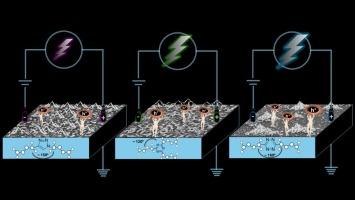二咔唑单体电沉积薄膜的光电性能:桥接几何和电子结构之间的相互作用
IF 6.3
2区 化学
Q1 POLYMER SCIENCE
引用次数: 0
摘要
本研究报告了结构相关的供体-受体电活性单体的设计、合成和表征,每个电活性单体包括可电聚合的咔唑单元,通过单键连接到中心杂环,即1,4-三唑、s-三嗪或s-四嗪。这些杂环作为桥接框架,定义了单体结构中咔唑基团之间的空间排列。我们探讨了这种系统的结构变化如何影响电聚合动力学、电化学行为、电荷输运、光电性能和电沉积膜的形态。我们的研究结果表明杂环核的电子性质和咔唑单元的相对取向在决定所得聚合物的电荷输运性质方面起着关键作用。这些发现强调了分子设计在调整电沉积聚合物材料的电子和光电子性能方面的重要性。本文章由计算机程序翻译,如有差异,请以英文原文为准。

Optoelectronic properties of electrodeposited films from dicarbazole-linked monomers: interplay between bridging geometry and electronic structure
This study reports the design, synthesis, and characterization of structurally related donor–acceptor electroactive monomers, each comprising electropolymerizable carbazole units connected via a single bond to a central heterocyclic ring namely, 1,4-triazole, s-triazine, or s-tetrazine. These heterocycles act as bridging frameworks that define the spatial arrangement between the carbazole moieties within the monomer structure. We explore how such systematic structural variations influence the electropolymerization kinetics, electrochemical behavior, charge transport, optoelectronic properties, and morphology of the electrodeposited films. Our results reveal that both the electronic nature of the heterocyclic core and the relative orientation of the carbazole units play a key role in determining the charge transport properties of the resulting polymers. These findings underscore the importance of molecular design in tailoring the electronic and optoelectronic performance of electrodeposited polymeric materials.
求助全文
通过发布文献求助,成功后即可免费获取论文全文。
去求助
来源期刊

European Polymer Journal
化学-高分子科学
CiteScore
9.90
自引率
10.00%
发文量
691
审稿时长
23 days
期刊介绍:
European Polymer Journal is dedicated to publishing work on fundamental and applied polymer chemistry and macromolecular materials. The journal covers all aspects of polymer synthesis, including polymerization mechanisms and chemical functional transformations, with a focus on novel polymers and the relationships between molecular structure and polymer properties. In addition, we welcome submissions on bio-based or renewable polymers, stimuli-responsive systems and polymer bio-hybrids. European Polymer Journal also publishes research on the biomedical application of polymers, including drug delivery and regenerative medicine. The main scope is covered but not limited to the following core research areas:
Polymer synthesis and functionalization
• Novel synthetic routes for polymerization, functional modification, controlled/living polymerization and precision polymers.
Stimuli-responsive polymers
• Including shape memory and self-healing polymers.
Supramolecular polymers and self-assembly
• Molecular recognition and higher order polymer structures.
Renewable and sustainable polymers
• Bio-based, biodegradable and anti-microbial polymers and polymeric bio-nanocomposites.
Polymers at interfaces and surfaces
• Chemistry and engineering of surfaces with biological relevance, including patterning, antifouling polymers and polymers for membrane applications.
Biomedical applications and nanomedicine
• Polymers for regenerative medicine, drug delivery molecular release and gene therapy
The scope of European Polymer Journal no longer includes Polymer Physics.
 求助内容:
求助内容: 应助结果提醒方式:
应助结果提醒方式:


